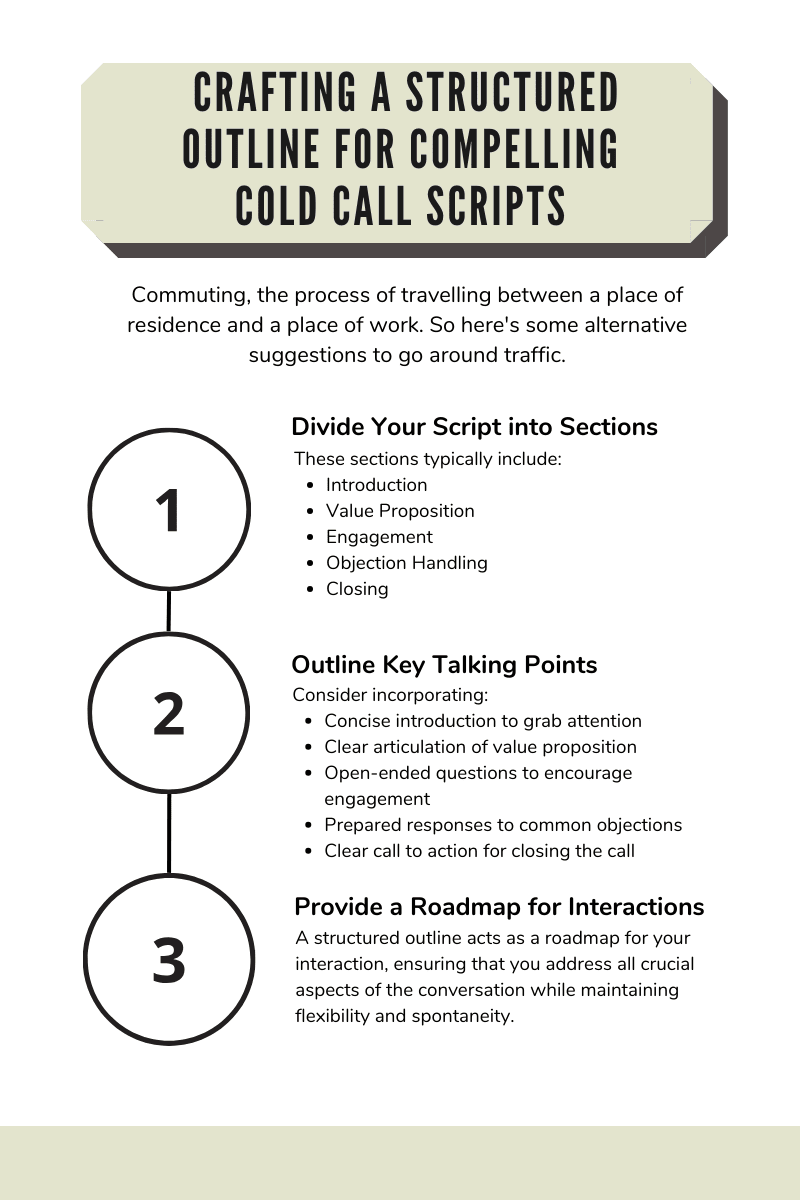How to Craft Compelling Cold Call Scripts: A Step-by-Step Guide
Mastering the art of cold calling is indispensable for success in the competitive sales landscape. Having a well-crafted sales script can make all the difference in engaging prospects and closing deals, whether you’re in real estate or insurance.
In this comprehensive guide, we’ll explore the intricacies of crafting compelling sales scripts tailored to cold calling, with a focus on real estate and insurance sectors.
Chapters
- Comprensione del tuo pubblico
- Stabilire obiettivi chiari
- Ricercare i tuoi potenziali clienti
- Creazione di uno schema strutturato
- Creare un'introduzione che attiri l'attenzione
- Costruire rapporti e fiducia
- Presentare la tua proposta di valore
- Gestire le obiezioni con sicurezza
- Chiudere la chiamata in modo efficace
- Testare e iterare il tuo script
- Conclusione
- Domande frequenti
Understanding Your Audience

Before diving into the script-writing process, it’s crucial to have a deep understanding of your target audience. In real estate cold call scripts, this might involve knowing whether your prospects are first-time homebuyers, property investors, or individuals looking to upgrade. Understanding the specific needs and concerns of different demographic groups in insurance, such as young families or retirees, can significantly impact the effectiveness of your script. Analyze demographics, pain points, and motivations to tailor your script effectively.
Setting Clear Objectives
Define clear objectives for each cold call. Are you aiming to schedule a meeting, gather information, or close a sale? Having specific goals helps guide the direction of the conversation and increases the likelihood of success. For example, cold call scripts for real estate, your objective might be to schedule a property viewing, while in cold call scripts for insurance, it could be to set up a consultation to discuss coverage options.
Researching Your Prospects
Take the time to research your prospects before reaching out. Utilize resources such as social media, company websites, and industry reports to gather information about their business or personal needs, recent activities, and pain points. This knowledge enables you to personalize your approach and establish rapport more effectively. For instance, knowing that a potential homebuyer recently relocated to the area could inform your conversation and help you tailor your pitch accordingly.
|
Step |
Description |
|
Identify the specific demographics, industries, or personas that align with your product or service offering. |
|
Explore platforms such as LinkedIn, Twitter, and Facebook to gain insights into prospects’ professional backgrounds and interests. |
|
Review company websites to understand their products, services, company culture, and recent news or announcements. |
|
Access industry reports and publications to stay updated on market trends, challenges, and opportunities relevant to prospects. |
|
Look for personal indicators such as recent relocations, career advancements, or life events that may influence their decision-making. |
|
Take note of any recent activities or engagements, such as attending webinars, participating in events, or sharing content online. |
|
Determine the challenges or pain points that prospects may be facing in their business or personal lives, based on available information. |
|
Organize the gathered information into a centralized database or CRM system for easy reference and retrieval during outreach efforts. |
Creating a Structured Outline
Crafting a structured outline for your cold call script ensures covering all essential points while maintaining a natural flow of conversation. Divide your script into sections such as introduction, value proposition, engagement, objection handling, and closing. Within each section, outline key talking points and questions to guide the conversation seamlessly. This structure offers a roadmap for your interaction while allowing flexibility and spontaneity.

Crafting an Attention-Grabbing Introduction
The first few seconds of a cold call are crucial for capturing the prospect’s attention. Develop an introduction that is concise, engaging, and tailored to resonate with the needs or interests of your audience. For instance, In real estate, mentioning recent market trends or a unique property listing that aligns with the prospect’s preferences can be effective. In insurance, highlighting recent regulatory changes or offering a quick insurance-related tip can pique interest and initiate a meaningful conversation.
Building Rapport and Trust
Building rapport is essential for establishing a connection with your prospect. Use active listening techniques, ask relevant questions, and demonstrate empathy to foster trust and credibility. In real estate, showing genuine interest in the prospect’s housing preferences and sharing insights about the local market can help build rapport. In insurance, actively listening to the prospect’s concerns about coverage gaps or affordability demonstrates empathy and positions you as a trusted advisor.
Presenting Your Value Proposition
Clearly articulate the value proposition of your product or service in a way that addresses the prospect’s pain points or challenges. Focus on benefits rather than features and tailor your message to resonate with the prospect’s needs. In real estate, emphasize the unique selling points of a property, such as its location, amenities, or potential for appreciation. In insurance, highlight the peace of mind and financial security that comprehensive coverage can provide, addressing specific concerns raised by the prospect.
Handling Objections with Confidence
Anticipate common objections that prospects may raise and prepare persuasive responses in advance. Approach objections as opportunities to address concerns and provide reassurance rather than roadblocks to the conversation. In real estate, common objections might revolve around pricing, location, or property condition, while in insurance, concerns about premiums, coverage limits, or policy exclusions are typical. By proactively addressing these objections with confidence and expertise, you can alleviate the prospect’s hesitations and move the conversation forward.
Closing the Call Effectively
Guide the conversation toward a desired outcome by using closing techniques that encourage action. Whether it’s scheduling a follow-up meeting, arranging a property viewing, or finalizing an insurance application, ensure that you have a clear call to action. In real estate, inviting the prospect to tour a property or meet with you to discuss their housing needs further can help solidify their interest. In insurance, offering to provide a personalized quote or review their existing coverage plan demonstrates your commitment to helping them make informed decisions.
Testing and Iterating Your Script
Continuously evaluate the effectiveness of your cold call script by tracking metrics such as response rates, conversion rates, and feedback from prospects. Use this data to refine and iterate your script for improved results over time. Experiment with different approaches, language choices, and value propositions to see what resonates best with your target audience. By staying agile and receptive to feedback, you can adapt your script to evolving market conditions and maximize your success in cold calling efforts.
Conclusion
In conclusion, crafting effective sales scripts for cold calling requires careful planning, research, and refinement. By understanding your audience, setting clear objectives, and following a structured approach, you can create scripts that resonate with prospects and drive success in the competitive realms of real estate and insurance sales. Remember to adapt and evolve your scripts based on feedback and performance metrics to stay ahead in the game. With dedication and persistence, mastering the art of cold calling can help you achieve your sales goals with confidence.
Frequently Asked Questions
How do I tailor my cold call script to different industries or target audiences?
Research your target audience and customize your script with language and examples that resonate with each industry or demographic group.
What are some effective strategies for grabbing the prospect’s attention in the opening of a cold call?
Lead with a compelling and personalized statement or question to demonstrate relevance and interest from the outset.
How do I handle objections confidently during a cold call?
Anticipate objections, listen actively, acknowledge concerns, and respond with relevant information or solutions to overcome objections positively.
Improve your Marketing with the Power of AI
See how you can start with AI Marketing and reach your goals faster than ever before. Check out the Tips, Strategies, AI Tools, Masterclass, Courses, and Community. Unleash the true potential of your brand with the help of AI.